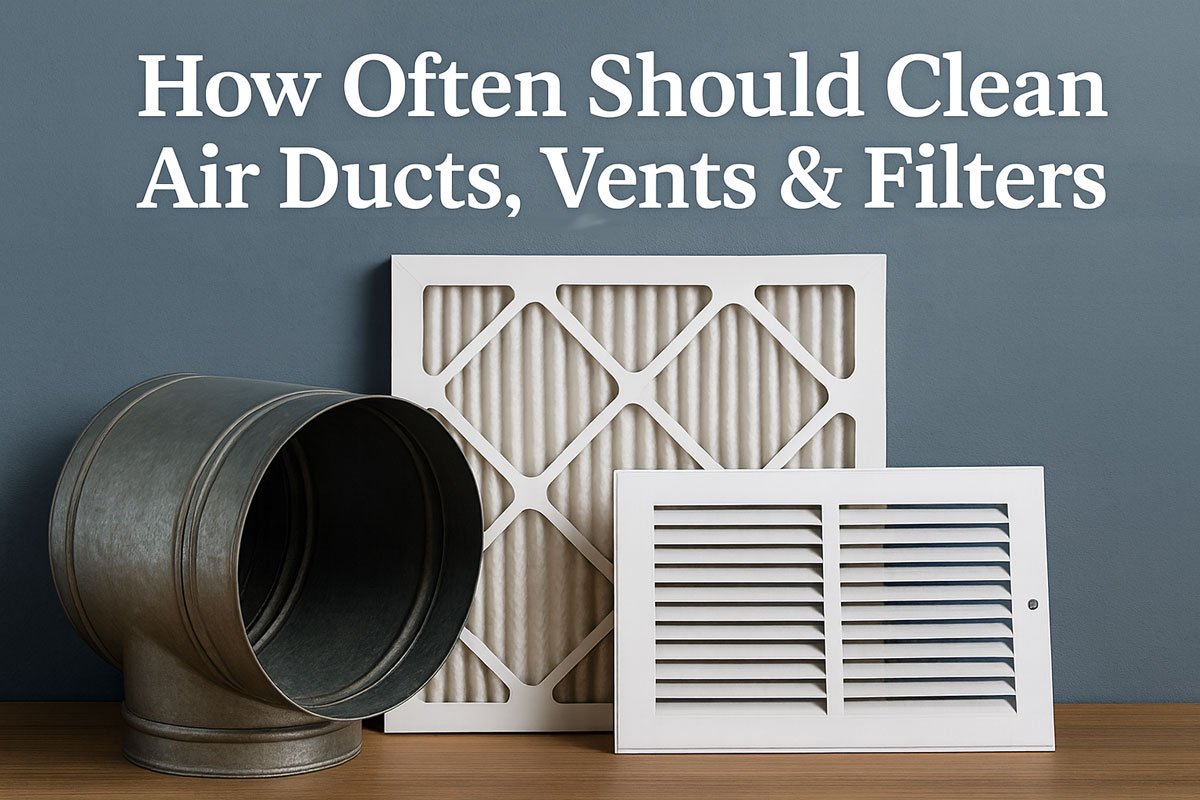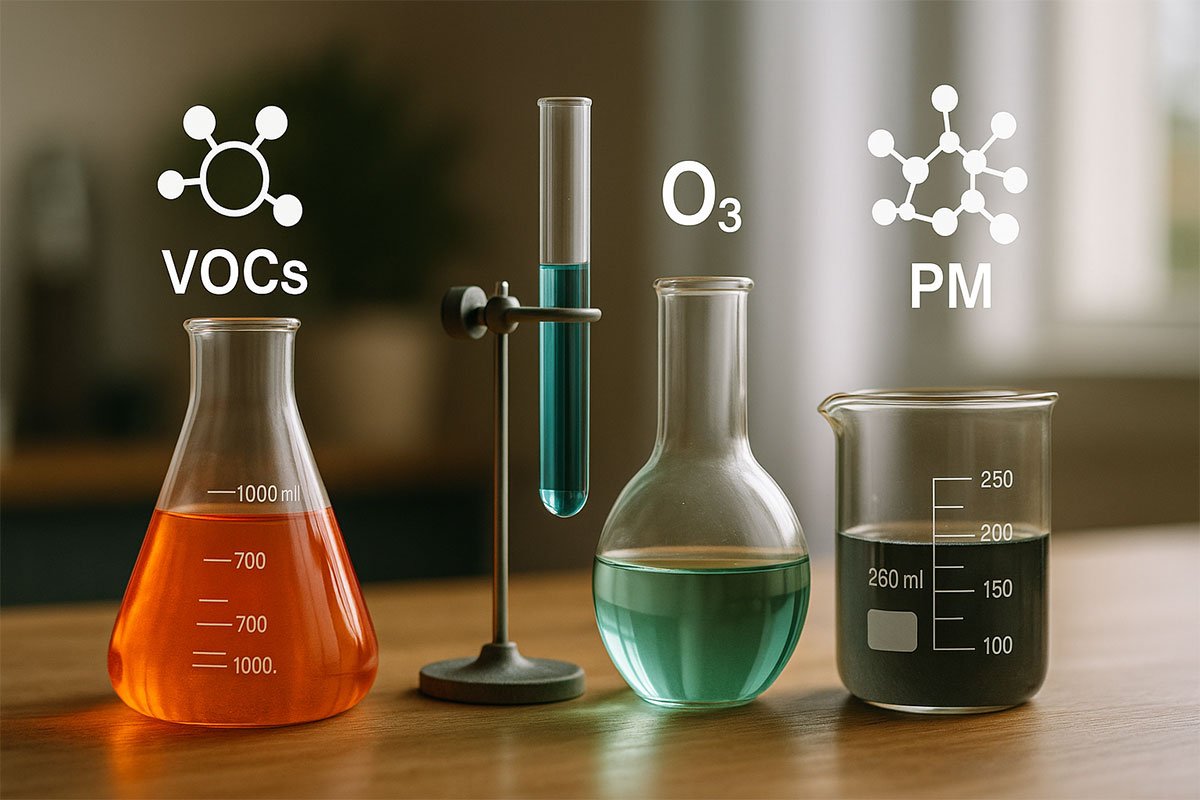A Science-Based Guide for Healthier Indoor Air
Indoor air quality has become one of the most important aspects of a healthy home, especially as modern buildings have become more energy-efficient and tightly sealed. While airtight construction prevents heat loss and reduces energy bills, it also reduces the amount of fresh outdoor air circulating through a home. As a result, dust, pollen, pet dander, combustion particles, textile fibers, volatile organic compounds (VOCs), and microbial fragments tend to accumulate and recirculate through the ventilation and HVAC system. Air ducts, supply vents, return vents, and HVAC filters all play crucial roles in capturing, holding, or redistributing these particles. Understanding how often these components should be cleaned or replaced requires an evidence-based approach grounded in building-science research rather than guesswork or sales-driven recommendations.
Every HVAC system is essentially the “respiratory system” of the home. As the system runs, air travels through ducts and vents repeatedly throughout the day. During this process, airborne particles settle inside the ductwork or become trapped in filters. Over time, dust buildup, pet hair, mold spores, and other contaminants can accumulate in the system’s interior surfaces. While not always visible, these accumulations can influence airflow, energy efficiency, and indoor air quality. Ducts that remain dirty or clogged for years can gradually release particles back into the living space, affecting sensitive individuals or contributing to unpleasant odors. However, the science around duct cleaning is more nuanced than many homeowners realize: most research shows that ducts typically do not need frequent cleaning unless specific issues exist.
The key to understanding maintenance frequency lies in the fundamental functions of the system. HVAC filters are designed to capture airborne particles before they reach the ducts. Vents and registers control and distribute air, often acting as the first surfaces where dust collects. Ducts, meanwhile, carry air throughout the house. Each component therefore has its own maintenance schedule. Despite the simplicity of these functions, homes vary widely in how quickly contaminants accumulate. A home with pets, smokers, recent renovations, or high outdoor pollution will accumulate particles much faster than a low-occupancy home without pets. Likewise, homes in dry climates may deal with more airborne dust, while humid climates may require more frequent filter replacement due to moisture and microbial activity.
Because of these differences, scientific and technical organizations such as the Environmental Protection Agency (EPA) and the National Air Duct Cleaners Association (NADCA) recommend cleaning ducts only when certain conditions are present, rather than following a fixed schedule. Filters, however, require consistent replacement because they act as the first line of defense. Understanding these distinctions helps homeowners avoid unnecessary costs while still maintaining optimal indoor air quality.
To break this down clearly, the following list outlines the typical maintenance intervals recommended by authoritative sources.
Recommended Cleaning & Replacement Intervals
- HVAC filters: Replace every 1–3 months, depending on filter type, pets, dust levels, and HVAC usage
- Supply and return vents: Clean visibly every 1–3 months to reduce surface dust and improve airflow
- Air ducts: Clean every 3–5 years, and sooner if there are specific problems such as mold, pests, or severe dust buildup
- Dryer vents (related but separate): Clean annually due to fire risk
These recommendations are general guidelines; the actual frequency can change for homes with special circumstances. For example, a home with three dogs may need filters replaced every 30–45 days, while a vacation home may need replacement only every few months because the HVAC system runs less frequently. Similarly, an older home with poorly sealed ductwork may accumulate dust faster than a newer home built to modern air-sealing standards.
Understanding why these intervals matter requires a closer look at what happens inside the system. HVAC filters progressively become clogged as they capture airborne debris. A clogged filter reduces airflow, forcing the HVAC system to work harder, which increases energy consumption and shortens the lifespan of the equipment. Poor airflow can also reduce the system’s ability to dehumidify or heat/cool efficiently. On the other hand, when filters are replaced regularly, ductwork remains cleaner for longer, reducing the need for professional duct cleaning.
Supply and return vents, due to their direct exposure to the room environment, accumulate dust rapidly. This dust is usually superficial and easy to wipe away, but if neglected, it can be drawn into the duct system and contribute to buildup over time. Regular vent cleaning also helps homeowners visually inspect for unexpected issues such as mold, condensation, or insect activity.
Duct cleaning is more complex. While some companies promote annual duct cleaning, scientific evaluations show that ducts do not typically require frequent cleaning unless certain conditions exist. Because ducts are enclosed systems, they do not accumulate dust at the same rate as open surfaces. Most of the dust inside ductwork adheres to the walls and does not re-enter the living space unless dislodged. However, when contaminants accumulate excessively or moisture infiltrates the ducts, cleaning becomes necessary to prevent circulation of airborne pollutants.
To help homeowners determine whether duct cleaning is actually needed, the following list outlines the most common signs that warrant professional cleaning:
Signs You May Need Air Duct Cleaning
- Visible mold inside ducts or on HVAC components
- Musty or persistent odors originating from the duct system
- Excessive dust coming from vents even after cleaning the home
- Pest infestations (rodents, insects) inside the ductwork
- Recent renovations that produced high levels of dust or debris
- Clogged registers with dense pet hair or fibrous material
- Unusual allergy symptoms that worsen when the HVAC runs
- Poor airflow due to debris restriction in certain sections
If none of these conditions are present, duct cleaning is typically not urgent. Instead, maintaining good filtration and replacing filters consistently can prevent most duct contamination issues. Homes with high-efficiency particulate air (HEPA) filters or MERV 11–13 filters typically require less frequent duct cleaning because these filters remove more fine particles before they enter the system.
Another important factor in determining cleaning frequency is the presence of moisture. If humidity infiltrates ductwork, condensation can develop, which may foster mold growth. Insufficiently insulated ducts—especially in humid climates or unconditioned attics—can experience temperature differences that produce moisture inside the system. Once mold begins to grow, duct cleaning becomes essential, and additional repairs or insulation may be required. Moisture issues always require immediate intervention because mold spores can circulate through the HVAC system and spread to other parts of the home.
Dust accumulation within ducts can also be influenced by duct design. Poorly sealed or poorly connected ducts can draw dust from attics, crawlspaces, or wall cavities. If ducts are leaking, cleaning them without sealing them is ineffective. In these cases, duct sealing using mastic or specialized aerosol sealing technology can dramatically improve indoor air quality and reduce dust buildup.
Beyond cleanliness, air duct maintenance plays a role in energy efficiency. Studies show that HVAC systems with clean filters and unobstructed airflow use significantly less energy. Even moderately clogged filters can increase energy consumption by 5–15%. Regular maintenance therefore reduces utility bills and extends the system’s lifespan.
Homeowners can also improve system performance by periodically checking airflow at each vent. If a particular room has weaker airflow, it could indicate a blocked duct, crushed flexible duct segment, or excessive dust accumulation in that branch. In multi-story homes, imbalances between floors may require adjustments to dampers or improvements in duct design.
At the end of the day, the goal is not simply to clean ducts on a strict schedule, but to monitor the HVAC system holistically for signs of reduced air quality or airflow. Maintaining indoor air quality requires a combination of routine filter replacement, occasional vent cleaning, managing humidity, and addressing problems as they arise. Keeping the system dry, well-filtered, and well-sealed prevents most long-term issues.
While ducts themselves may not need frequent cleaning, filters absolutely do. Filters protect both the ductwork and the air occupants breathe. Skipping filter replacements increases indoor dust, worsens allergies, and forces the HVAC system to work harder. Vent cleaning, meanwhile, is simple but effective—just wiping down the metal surfaces or vacuuming the openings with a brush attachment reduces dust movement into the system.
Indoor air quality depends heavily on these basic maintenance practices. Homes with clean, well-maintained HVAC systems have fewer airborne allergens, reduced dust buildup, better humidity control, and more consistent temperature distribution. Indoor environments feel fresher, smell cleaner, and support healthier breathing.
Ultimately, knowing how often to clean air ducts, vents, and filters is not about overmaintaining the system—it’s about maintaining it correctly, based on evidence. Filters need frequent replacement. Vents need periodic cleaning. Ducts need occasional inspection and cleaning when specific issues occur. Following these guidelines leads to better airflow, lower energy bills, longer HVAC lifespan, and a cleaner home environment.
Scientific Sources
- U.S. Environmental Protection Agency (EPA) – “Should You Have the Air Ducts in Your Home Cleaned?”
https://www.epa.gov/indoor-air-quality-iaq/should-you-have-air-ducts-your-home-cleaned - National Air Duct Cleaners Association (NADCA) – Residential Cleaning Guidelines
https://nadca.com - ASHRAE – Indoor Air Quality Standards
https://www.ashrae.org/technical-resources/standards-and-guidelines




